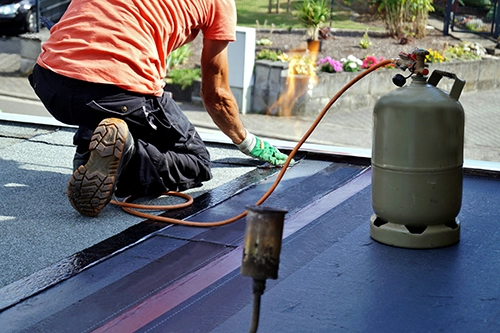- About Us
- Services
- Blog
- Contact
Need a quote?
Choosing the right roofing material is a big decision for property owners. Whether you need residential roofing in London or you’re managing a commercial roofing project, your choice needs to take into account appearance, durability, cost, as well as longevity and price.
In this article, we’re going to break down three of the most common roofing options: slate, tile and flat roofing.




Slate is a great choice for many homes across London, especially those in heritage areas.
Slate is:
Whilst it is more expensive upfront, it’s a long-term investment with minimal maintenance needs. At Environ Roofing Services, we specialise in slate roofing, particularly for period properties and those in conservation areas.
Tile roofs are often made from clay or concrete, and they are common across numerous London suburbs, especially in new-build properties.
Benefits of tile roofing include:
Tiles can work for both residential and commercial roofing, in London properties. They’re great for situations where aesthetics are important, but these need to be balanced with budget, too.
Flat roofs are commonly used for home extensions, garden buildings like offices, commercial buildings and warehouses, or residential developments with modern architectural designs. Materials like EPDM rubber, GRP fibreglass or felt are the most commonly used materials, offering lifespans up to 30 years.
At Environ Roofing Services, we work with felt roofing for both commercial and residential roofing clients.
Whether you’re looking for residential or commercial roofing solutions, we can help you.
We’re dedicated to building long-term relationships with our clients and the community by providing residential and commercial services in the UK with the best standards of workmanship and customer support. We work with dedication and integrity and strive to lead the way in the roofing industry.
It depends on the construction, but the minimum weight a flat roof must be capable of bearing is 300lbs. This refers to a concentrated weight where a load is positioned on just one area of the roof. So, for example, a commercial flat roof can approximately support a 300lb HVAC unit in a 2.5×2.5ft single space.
If you opt for a flat roof anywhere on your property, remember that it comes with a need for proper maintenance. Low-slope roofing London-wide should be checked every six months or so, or after spells of bad weather, to spot any signs of damage. No matter how small, these should be addressed before they escalate. Remove any debris (leaves, twigs and so on) regularly to avoid these blocking the gutters and allowing water to pool and stand on the roof.
If there are trees in the close vicinity, keep them cut back to reduce the amount of foliage that falls on your flat roof. And check internally for signs of moisture, dampness or water damage on a regular basis. Spotting problems early means resolving them will be cheaper in the long run.

Building a flat roof can be done in three ways. The simplest and most cost-effective choice for levelled roofing London-wide is to construct a warm roof where a roofing membrane is placed over the insulation that keeps the timber structure warm. Another option is to create a cold roof where insulation is positioned between the rafters under the ply roof covering. This is commonly applied to flat-roofed extensions.
The third method is the hybrid roof that contains diverse elements. Their designs require a gap of ventilation above a warm roof to prevent excess moisture within the roof structure.
If you’re looking for flat roofing local contractors, don’t just select the first firm you come across. Find a roofing company that’s been in business for a while and can demonstrate a good track record in installing, repairing, and replacing flat roofs specifically. Ask for recommendations from your own network or from a local trade association. If you need refurbishment work done to 50% or more of your roof, you’ll need a roofing contractor who can self-certify their work under the Competent Person Scheme. Otherwise, the Building Control department at your local authority will need to approve the job before it begins.
Ask whether they are covered by liability insurance and how long they’ll guarantee the work they will carry out. And never just opt for the cheapest quote unless you’re quite sure they’re the best company for the job. You can’t afford to compromise on your roof as the structural integrity of your property depends on it.
Ensuring your flat roof will comply with building regulations before installation can save property owners time, money and stress. First, the roof must have a slope of around 1:80, with water draining away to one or two roof edges. Waterproofing must be extended up to the adjacent walls with at least 150 mm from the surface of the roof.
Contractors must install ventilation in cold roofs. For warm roofs, the deck must be bonded with a VCL. The roof should have the capacity to withstand strong winds and be sturdy enough to take an individual’s weight. Finally, check whether planning permission is needed. Typically, this is only required if you live in a conservation area or a listed building, or are making significant changes to an existing roof.
If you’re looking for top roofing solutions at competitive rates, check out our range of roofing services at Environ Roofing Company London. To get started, call one of our representatives today!

